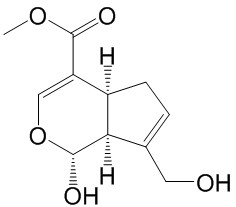Home
Products
Genipin



| Product Name | Genipin |
| Price: | $15 / 20mg |
| Catalog No.: | CN03184 |
| CAS No.: | 6902-77-8 |
| Molecular Formula: | C11H14O5 |
| Molecular Weight: | 226.23 g/mol |
| Purity: | >=98% |
| Type of Compound: | Iridoids |
| Physical Desc.: | White powder |
| Source: | The fruits of Gardenia jasminoides Ellis |
| Solvent: | Chloroform, Dichloromethane, Ethyl Acetate, DMSO, Acetone, etc. |
| SMILES: | COC(=O)C1=CO[C@H]([C@H]2[C@@H]1CC=C2CO)O |
| Contact us | |
|---|---|
| First Name: | |
| Last Name: | |
| E-mail: | |
| Question: | |
| Description | Genipin is a natural water soluble crosslinking reagent. |
| In Vitro | Genipin stimulats glucose uptake in a time- and dose-dependent manner. The maximal effect is achieved at 2 h with a concentration of 10 μM. In myotubes, genipin promotes glucose transporter 4 (GLUT4) translocation to the cell surface, which increases the phosphorylation of insulin receptor substrate-1 (IRS-1), AKT, and GSK3β. Meanwhile, genipin increases ATP levels, closed KATP channels, and then increases the concentration of calcium in the cytoplasm in C2C12 myotubes. Genipin-stimulated glucose uptake could be blocked by both the PI3-K inhibitor wortmannin and calcium chelator EGTA. Moreover, genipin increases the level of reactive oxygen species and ATP in C2C12 myotubes[1]. Genipin increases mitochondrial membrane potential, which then increases ATP levels and closes KATP channels, thereby stimulating insulin secretion in pancreatic β-cells. Genipin activates glucose-excited POMC neurons[2]. Cytochrome c content increases significantly in the cytosol of genipin-treated FaO cells. Activation of caspase-3 and caspase-7 is ultimately responsible for genipin-induced apoptotic process in hepatoma cells. ROS level notably increases in Hep3B cells treated with 200 μM genipin[3]. |
| Density | 1.4±0.1 g/cm3 |
| Boiling Point | 416.0±45.0 °C at 760 mmHg |
| Flash Point | 164.9±22.2 °C |
| Exact Mass | 226.084122 |
| PSA | 75.99000 |
| LogP | 0.12 |
| Vapour Pressure | 0.0±2.2 mmHg at 25°C |